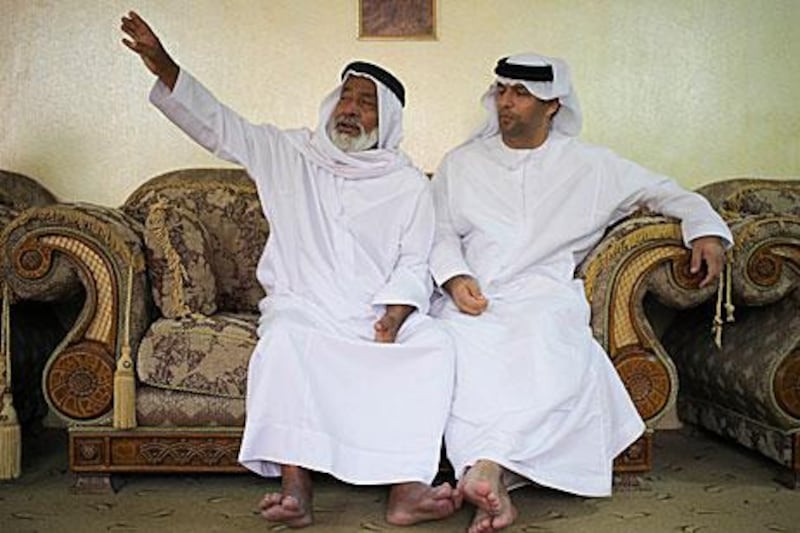RAS AL KHAIMAH // Sheikh Shaiban bin Mohammed speaks of weddings, bullets and the glorious past, insisting he is speaking Arabic – and yet only his sons can understand him.
"It's only an accent, a dialect" says his son Ahmed, 36, translating for his father into Gulf Arabic.
Arabs who have not lived around the mountains of Ras Al Khaimah cannot understand elders such as Sheikh Shaiban of the Habus tribe, who maintains an immaculately trimmed white beard at the age of 80.
He speaks in the Shehhi dialect of the UAE’s northern cape – the north of Ras Al Khaimah, Dibba and the Omani exclave of Musandam – with its round vowels, throaty tone and drawn-out Rs that bear more resemblance to a Texan drawl.
The puzzle of the origins of the Shehhi dialect has confounded explorers for centuries. Historians attributed its quirks to the influence of Persian and even Portuguese. For years, people believed the language was unrelated to Arabic.
Now a linguist from UAE University has found evidence to confirm what Sheikh Shaiban and his family have always maintained: that Shehhi history in the peninsula spans millennia.
Dr Maryam Bayshak believes the dialect spoken by the people of the Ru’us Al Jibal mountains is a remnant of a south semitic language that predates the Arabic dialect of surrounding areas.
The linguist has researched Shehhi for more than two decades and is writing a book that reconstructs the linguistic history of the community who speak it.
“I look at the Shehhi language as a historical point of view, from a socio-linguistics point of view, from a cultural point of view,” says Dr Bayshak.
“I think it is as important as archaeological excavation. Language is just part of the documentation of the history of the people.”
The dialect has two branches: the Shehhi spoken by mountain summit dwellers from Ru’us Al Jibal; and Kumzari, a dialect of the Musandam Peninsula that shares the same parent language but has characteristics of Sassanid Middle Persian.
Dr Bayshak hypothesises that this proto-language of southern Arabia was once widely spoken. But while in most areas it was superseded by other varieties of Arabic, the mountain dwellers in their isolation kept more elements of the original.
Shehhi remains widely spoken in the Musandam cape, in communities such as Ghalilah, Sha’am, Al Jir, Dibba, Khatt and Khasab.
Dr Bayshak believes it is based on the language of the Himyarite dynasty, an agrarian kingdom established in the south-west of Yemen in the second century BC, which built its wealth on the trade in frankincense and myrrh. They adopted Sabaean as a written language and spread south-east across the peninsula, bringing their language with them.
Shehhi, she believes, is probably derived from Himyarite or an outlaying sect of Sabaean language from this time.
>>>
National View blog - Traditions and lifestyle: Shehhuh tribe of the Northern Emirates
>>>
It may have spread east with the migration that followed the collapse of the Marib dam in the second century BC. Coastal trade increased as merchants avoided the taxes that were being imposed in the interior.
Dr Bayshak’s first clues were the phonetics shared by Shehhi and modern south-west Arabian languages.
Shehhi merges certain consonants and vowels. In Shehhi the distinctive “ayn” of Arabic (as in “aneb”, or grape) is spoken like an “a” as in apple, and the “dh” is pronounced “d” as in dog.
More evidence is on the map. Poring over the musty pages of a Sabaean dictionary in Oxford, Dr Bayshak discovered that place names across the northern emirates, from Dhaid to Digdagga, derived their roots from south semitic agrarian words.
Take Skumkum, a hamlet named from “kumkum” (frankincense), or Dhaid and Dhait, an area free of stones and suitable for irrigation. Dr Bayshak has scores of such examples.
Archaeological evidence supports this link. Coins and pottery suggest the area was in contact with south Arabian civilisations, if not a part of them.
East Arabian tribes had established ports and traded north to Mesopotamia – modern Iraq and north-eastern Syria.
Northern trade left its own imprint on the Shehhi dialect, which can be found in its vocabulary and the pronunciation of vowels at the end of some words.
The Shehhi pronounciation of flower, “wardi”, sounds more Lebanese than Gulf Arabic. Another example is the interrogatory "ki"(how?), which may derive from the ancient Mesopotamian language of Akkadian.
Shehhi grammar follows standard Arabic, except in verbal negation. In Emirati dialect “m” is used for negation.Shehhi often uses the word “la” (no) after the verb for negation instead.
It is the English equivalent of saying, "I’m going, no" instead of "I’m not going”.
More research is needed, though. "Maybe people will die … but the language will remain," says Dr Bayshak.
"We always say that language and the vocabulary of the language will remain forever, and we have to preserve it." On that point, Sheikh Shaiban is adamant.
“It’s going to stay,” he says. “It’s our pride, our pride and joy.”
His friend, Ali Rashed, an amir of Wadi Qada’a, nods in agreement. He was 15 years old and a Grade 1 pupil the first time he heard a foreign dialect.
"Without this we would all be lost," says the Wadi Baih elder, who believes he is in his eighties. "It’s our ancestry. This, this is our identity."
azacharias@thenational.ae






